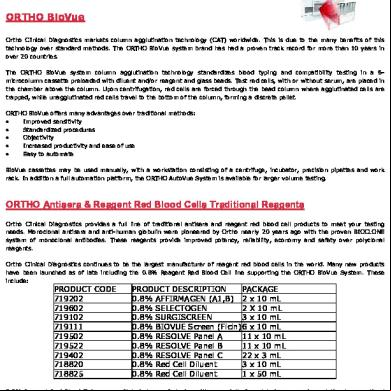Horrock Ortho Toludine Water Sampling 4k276e
This document was ed by and they confirmed that they have the permission to share it. If you are author or own the copyright of this book, please report to us by using this report form. Report 2z6p3t
Overview 5o1f4z
& View Horrock Ortho Toludine Water Sampling as PDF for free.
More details 6z3438
- Words: 432
- Pages: 12
Water Practicals
HORROCKS APPARATUS
Designed to find out the dose of bleaching powder required for disinfection of water.
CONTENTS
6 white cups( 200ml capacity) 1 black cup with circular mark inside 2 metal spoons(2g capacity) 7 glass stirring rods 1 special pipette 2 droppers Starch– iodide indicator solution Instruction folder
PROCEDURE
Take 2g of bleaching powder in the black cup, make it into a thin paste with little water. Add more water to paste & make up volume up to circular mark with stirring. Fill 6 white cups with water to be tested up to 1 cm below the brim.
With the special pippette provided add one drop of stock soln to 1st cup, 2 drops to the 2nd cup and so on.. Stir the water in each cup with separate rod. wait for half hour for the action of chlorine. Add 3 drops of starch– iodide indicator to each. Development of blue color indicates presence of free residual chlorine.
Calculations
Suppose 3rd cup develops blue color. Then 3 x 2 g of bleaching powder is needed to disinfect 455 l of water. Therefore the quantity needed (x) to disinfect (y) l of water will be = 6 y / 455
Orthotoludine test
0.1ml OT reagent to 1 ml of water. Yellow colour develops proportionate to cl concentration. Measured by chloroscope.
SAMPLING FOR PHYSICAL & CHEMICAL ASSESMENT sample collected in clean glass stoppered bottles made of neutral glass of capacity not less than 2ltrs. FOR BACTERIOLOGICAL EXAMINATION sample collected in clean sterilized bottles made of neutral glass, capacity of 250ml, with a ground glass stopper having a overlapping rim.
SAMPLE FROM TAP WATER
Tap opened fully, let water run to waste for 2 min. Bottle held near the base with one hand & the stopper & paper cover over it removed together & held in fingers. Bottle should be filled from a gentle stream of water from tap, avoiding splashing.
Sampling from rivers, wells etc
Tie additional string to the bottle string. Dip bottle with string not with hands. Face mouth of bottle towards stream Generate current in still water. Location for the sampling
Transport & storage of Samples
the bacteriological examination of the sample should be commenced asap after collection. Water should be kept in ice until it is taken for analysis within 48hrs of collection. Samples not preserved in this manner should be rejected.
THANKYOU
HORROCKS APPARATUS
Designed to find out the dose of bleaching powder required for disinfection of water.
CONTENTS
6 white cups( 200ml capacity) 1 black cup with circular mark inside 2 metal spoons(2g capacity) 7 glass stirring rods 1 special pipette 2 droppers Starch– iodide indicator solution Instruction folder
PROCEDURE
Take 2g of bleaching powder in the black cup, make it into a thin paste with little water. Add more water to paste & make up volume up to circular mark with stirring. Fill 6 white cups with water to be tested up to 1 cm below the brim.
With the special pippette provided add one drop of stock soln to 1st cup, 2 drops to the 2nd cup and so on.. Stir the water in each cup with separate rod. wait for half hour for the action of chlorine. Add 3 drops of starch– iodide indicator to each. Development of blue color indicates presence of free residual chlorine.
Calculations
Suppose 3rd cup develops blue color. Then 3 x 2 g of bleaching powder is needed to disinfect 455 l of water. Therefore the quantity needed (x) to disinfect (y) l of water will be = 6 y / 455
Orthotoludine test
0.1ml OT reagent to 1 ml of water. Yellow colour develops proportionate to cl concentration. Measured by chloroscope.
SAMPLING FOR PHYSICAL & CHEMICAL ASSESMENT sample collected in clean glass stoppered bottles made of neutral glass of capacity not less than 2ltrs. FOR BACTERIOLOGICAL EXAMINATION sample collected in clean sterilized bottles made of neutral glass, capacity of 250ml, with a ground glass stopper having a overlapping rim.
SAMPLE FROM TAP WATER
Tap opened fully, let water run to waste for 2 min. Bottle held near the base with one hand & the stopper & paper cover over it removed together & held in fingers. Bottle should be filled from a gentle stream of water from tap, avoiding splashing.
Sampling from rivers, wells etc
Tie additional string to the bottle string. Dip bottle with string not with hands. Face mouth of bottle towards stream Generate current in still water. Location for the sampling
Transport & storage of Samples
the bacteriological examination of the sample should be commenced asap after collection. Water should be kept in ice until it is taken for analysis within 48hrs of collection. Samples not preserved in this manner should be rejected.
THANKYOU










